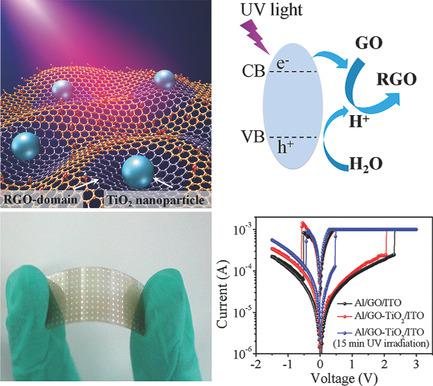Our official English website, www.x-mol.net, welcomes your
feedback! (Note: you will need to create a separate account there.)
Photocatalytic Reduction of Graphene Oxide–TiO2 Nanocomposites for Improving Resistive‐Switching Memory Behaviors
Small ( IF 13.0 ) Pub Date : 2018-06-21 , DOI: 10.1002/smll.201801325 Xiaoning Zhao 1 , Zhongqiang Wang 1 , Yu Xie 1 , Haiyang Xu 1 , Jiaxue Zhu 1 , Xintong Zhang 1 , Weizhen Liu 1 , Guochun Yang 1 , Jiangang Ma 1 , Yichun Liu 1
Small ( IF 13.0 ) Pub Date : 2018-06-21 , DOI: 10.1002/smll.201801325 Xiaoning Zhao 1 , Zhongqiang Wang 1 , Yu Xie 1 , Haiyang Xu 1 , Jiaxue Zhu 1 , Xintong Zhang 1 , Weizhen Liu 1 , Guochun Yang 1 , Jiangang Ma 1 , Yichun Liu 1
Affiliation

|
Graphene oxide (GO)‐based resistive‐switching (RS) memories offer the promise of low‐temperature solution‐processability and high mechanical flexibility, making them ideally suited for future flexible electronic devices. The RS of GO can be recognized as electric‐field‐induced connection/disconnection of nanoscale reduced graphene oxide (RGO) conducting filaments (CFs). Instead of operating an electrical FORMING process, which generally results in high randomness of RGO CFs due to current overshoot, a TiO2‐assisted photocatalytic reduction method is used to generate RGO‐domains locally through controlling the UV irradiation time and TiO2 concentration. The elimination of the FORMING process successfully suppresses the RGO overgrowth and improved RS memory characteristics are achieved in graphene oxide–TiO2 (Go‐TiO2) nanocomposites, including reduced SET voltage, improved switching variability, and increased switching speed. Furthermore, the room‐temperature process of this method is compatible with flexible plastic substrates and the memory cells exhibit excellent flexibility. Experimental results evidence that the combined advantages of reducing the oxygen‐migration barrier and enhancing the local‐electric‐field with RGO‐manipulation are responsible for the improved RS behaviors. These results offer valuable insight into the role of RGO‐domains in GO memory devices, and also, this mild photoreduction method can be extended to the development of carbon‐based flexible electronics.
中文翻译:

氧化石墨烯-TiO2 纳米复合材料的光催化还原可改善阻变记忆行为
基于氧化石墨烯(GO)的电阻开关(RS)存储器有望实现低温溶液加工性和高机械灵活性,使其非常适合未来的柔性电子设备。 GO 的 RS 可以被认为是电场引起的纳米级还原氧化石墨烯 (RGO) 导电丝 (CF) 的连接/断开。电成型过程通常会因电流过冲而导致 RGO CF 的高度随机性,而采用 TiO 2辅助光催化还原方法,通过控制 UV 照射时间和 TiO 2浓度来局部生成 RGO 域。消除成型过程成功地抑制了 RGO 过度生长,并在氧化石墨烯-TiO 2 (Go-TiO 2 ) 纳米复合材料中实现了改进的 RS 存储特性,包括降低的 SET 电压、改善的开关可变性和提高的开关速度。此外,该方法的室温工艺与柔性塑料基板兼容,并且存储单元表现出优异的柔性。实验结果证明,通过 RGO 操作减少氧迁移势垒和增强局部电场的综合优势是改善 RS 行为的原因。这些结果为了解 RGO 域在 GO 存储器件中的作用提供了有价值的见解,而且这种温和的光还原方法可以扩展到碳基柔性电子产品的开发。
更新日期:2018-06-21
中文翻译:

氧化石墨烯-TiO2 纳米复合材料的光催化还原可改善阻变记忆行为
基于氧化石墨烯(GO)的电阻开关(RS)存储器有望实现低温溶液加工性和高机械灵活性,使其非常适合未来的柔性电子设备。 GO 的 RS 可以被认为是电场引起的纳米级还原氧化石墨烯 (RGO) 导电丝 (CF) 的连接/断开。电成型过程通常会因电流过冲而导致 RGO CF 的高度随机性,而采用 TiO 2辅助光催化还原方法,通过控制 UV 照射时间和 TiO 2浓度来局部生成 RGO 域。消除成型过程成功地抑制了 RGO 过度生长,并在氧化石墨烯-TiO 2 (Go-TiO 2 ) 纳米复合材料中实现了改进的 RS 存储特性,包括降低的 SET 电压、改善的开关可变性和提高的开关速度。此外,该方法的室温工艺与柔性塑料基板兼容,并且存储单元表现出优异的柔性。实验结果证明,通过 RGO 操作减少氧迁移势垒和增强局部电场的综合优势是改善 RS 行为的原因。这些结果为了解 RGO 域在 GO 存储器件中的作用提供了有价值的见解,而且这种温和的光还原方法可以扩展到碳基柔性电子产品的开发。











































 京公网安备 11010802027423号
京公网安备 11010802027423号